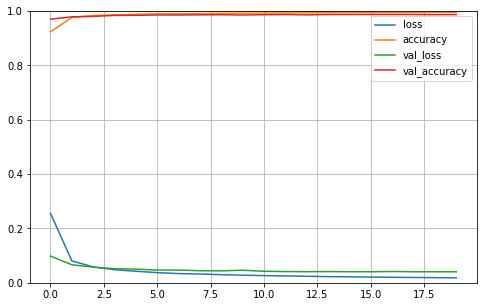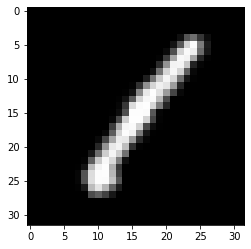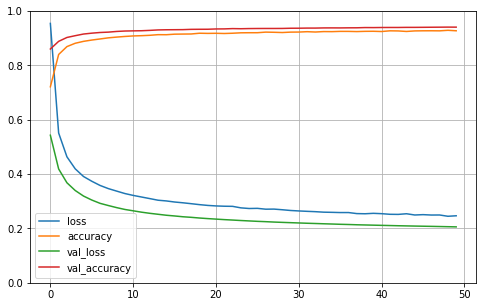[Kaggle] Digit Recognizer 手寫數位識別(折積神經網路)
2020-10-14 13:01:02
文章目錄
相關博文:
[Hands On ML] 3. 分類(MNIST手寫數位預測)
[Kaggle] Digit Recognizer 手寫數位識別
[Kaggle] Digit Recognizer 手寫數位識別(簡單神經網路)
04.折積神經網路 W1.折積神經網路
上一篇的簡單神經網路,將28*28的圖片展平了,每個畫素在空間上的位置關係是沒有考慮的,空間的資訊丟失。
1. 使用 LeNet 預測
LeNet神經網路 參考博文
1.1 匯入包
from keras import backend as K # 相容不同後端的程式碼
from keras.models import Sequential
from keras.layers.convolutional import Conv2D
from keras.layers.convolutional import MaxPooling2D
from keras.layers.core import Activation
from keras.layers.core import Dense
from keras.layers.core import Flatten
from keras.utils import np_utils
from keras.optimizers import SGD, Adam, RMSprop
import numpy as np
%matplotlib inline
import matplotlib.pyplot as plt
import pandas as pd
1.2 建立 LeNet 模型
# 圖片格式問題
# K.image_data_format() == 'channels_last'
# 預設是last是通道 K.set_image_dim_ordering("tf")
# K.image_data_format() == 'channels_first' # K.set_image_dim_ordering("th")
class LeNet:
@staticmethod
def build(input_shape, classes):
model = Sequential()
model.add(Conv2D(20,kernel_size=5,padding='same',
input_shape=input_shape,activation='relu'))
model.add(MaxPooling2D(pool_size=(2,2),strides=(2,2)))
model.add(Conv2D(50,kernel_size=5,padding='same',activation='relu'))
model.add(MaxPooling2D(pool_size=(2,2),strides=(2,2)))
model.add(Flatten())
model.add(Dense(500, activation='relu'))
model.add(Dense(classes,activation='softmax'))
return model
1.3 讀入資料
train = pd.read_csv('train.csv')
y_train_full = train['label']
X_train_full = train.drop(['label'], axis=1)
X_test_full = pd.read_csv('test.csv')
X_train_full.shape
輸出:
(42000, 784)
- 資料格式轉換,增加一個通道維度
X_train = np.array(X_train_full).reshape(-1,28,28) / 255.0
X_test = np.array(X_test_full).reshape(-1,28,28)/255.0
y_train = np_utils.to_categorical(y_train_full, 10) # 轉成oh編碼
X_train = X_train[:, :, :, np.newaxis]
# m,28,28 --> m, 28, 28, 1(單通道)
X_test = X_test[:, :, :, np.newaxis]
1.4 定義模型
model = LeNet.build(input_shape=(28, 28, 1), classes=10)
- 定義優化器,設定模型
opt = Adam(learning_rate=0.001, beta_1=0.9, beta_2=0.999, decay=0.01)
model.compile(loss="categorical_crossentropy",
optimizer=opt, metrics=["accuracy"])
注意:標籤不採用 one-hot 編碼的話,這裡使用 loss="sparse_categorical_crossentropy"
1.5 訓練
history = model.fit(X_train, y_train, epochs=20, batch_size=128,
validation_split=0.2)
Epoch 1/20
263/263 [==============================] - 26s 98ms/step -
loss: 0.2554 - accuracy: 0.9235 -
val_loss: 0.0983 - val_accuracy: 0.9699
Epoch 2/20
263/263 [==============================] - 27s 103ms/step -
loss: 0.0806 - accuracy: 0.9761 -
val_loss: 0.0664 - val_accuracy: 0.9787
...
...
Epoch 20/20
263/263 [==============================] - 25s 97ms/step -
loss: 0.0182 - accuracy: 0.9953 -
val_loss: 0.0405 - val_accuracy: 0.9868
可以看見第2輪迭代結束,訓練集準確率就 97.6%了,效果比之前的簡單神經網路好很多
- 模型總結
model.summary()
Model: "sequential"
_________________________________________________________________
Layer (type) Output Shape Param #
=================================================================
conv2d (Conv2D) (None, 28, 28, 20) 520
_________________________________________________________________
max_pooling2d (MaxPooling2D) (None, 14, 14, 20) 0
_________________________________________________________________
conv2d_1 (Conv2D) (None, 14, 14, 50) 25050
_________________________________________________________________
max_pooling2d_1 (MaxPooling2 (None, 7, 7, 50) 0
_________________________________________________________________
flatten (Flatten) (None, 2450) 0
_________________________________________________________________
dense (Dense) (None, 500) 1225500
_________________________________________________________________
dense_1 (Dense) (None, 10) 5010
=================================================================
Total params: 1,256,080
Trainable params: 1,256,080
Non-trainable params: 0
_________________________________________________________________
- 繪製模型結構圖
from keras.utils import plot_model
plot_model(model, './model.png', show_shapes=True)

1.6 繪製訓練曲線
pd.DataFrame(history.history).plot(figsize=(8, 5))
plt.grid(True)
plt.gca().set_ylim(0, 1) # set the vertical range to [0-1]
plt.show()

1.7 預測提交
y_pred = model.predict(X_test)
pred = y_pred.argmax(axis=1).reshape(-1)
print(pred.shape)
image_id = pd.Series(range(1,len(pred)+1))
output = pd.DataFrame({'ImageId':image_id, 'Label':pred})
output.to_csv("submission_NN.csv", index=False)


LeNet 模型得分 0.98607,比上一篇的簡單NN模型(得分 0.97546),好了 1.061%
2. 使用 VGG16 遷移學習
VGG16 help 檔案:
Help on function VGG16 in module tensorflow.python.keras.applications.vgg16:
VGG16(include_top=True, weights='imagenet', input_tensor=None, input_shape=None, pooling=None, classes=1000, classifier_activation='softmax')
Instantiates the VGG16 model.
Reference paper:
- [Very Deep Convolutional Networks for Large-Scale Image Recognition](
https://arxiv.org/abs/1409.1556) (ICLR 2015)
By default, it loads weights pre-trained on ImageNet. Check 'weights' for
other options.
This model can be built both with 'channels_first' data format
(channels, height, width) or 'channels_last' data format
(height, width, channels).
The default input size for this model is 224x224.
Caution: Be sure to properly pre-process your inputs to the application.
Please see `applications.vgg16.preprocess_input` for an example.
Arguments:
include_top: whether to include the 3 fully-connected
layers at the top of the network.
weights: one of `None` (random initialization),
'imagenet' (pre-training on ImageNet),
or the path to the weights file to be loaded.
input_tensor: optional Keras tensor
(i.e. output of `layers.Input()`)
to use as image input for the model.
input_shape: optional shape tuple, only to be specified
if `include_top` is False (otherwise the input shape
has to be `(224, 224, 3)`
(with `channels_last` data format)
or `(3, 224, 224)` (with `channels_first` data format).
It should have exactly 3 input channels,
and width and height should be no smaller than 32.
E.g. `(200, 200, 3)` would be one valid value.
pooling: Optional pooling mode for feature extraction
when `include_top` is `False`.
- `None` means that the output of the model will be
the 4D tensor output of the
last convolutional block.
- `avg` means that global average pooling
will be applied to the output of the
last convolutional block, and thus
the output of the model will be a 2D tensor.
- `max` means that global max pooling will
be applied.
classes: optional number of classes to classify images
into, only to be specified if `include_top` is True, and
if no `weights` argument is specified.
classifier_activation: A `str` or callable. The activation function to use
on the "top" layer. Ignored unless `include_top=True`. Set
`classifier_activation=None` to return the logits of the "top" layer.
Returns:
A `keras.Model` instance.
Raises:
ValueError: in case of invalid argument for `weights`,
or invalid input shape.
ValueError: if `classifier_activation` is not `softmax` or `None` when
using a pretrained top layer.
2.1 匯入包
import numpy as np
%matplotlib inline
import matplotlib.pyplot as plt
import pandas as pd
import cv2
from keras.optimizers import Adam
from keras.models import Model
from keras.utils import np_utils
from keras.models import Sequential
from keras.layers import Flatten
from keras.layers import Dense
from keras.layers import Input
from keras.layers import Dropout
from keras.applications.vgg16 import VGG16
2.2 定義模型
vgg16 = VGG16(weights='imagenet',include_top=False,
input_shape=(32, 32, 3))
# VGG16 模型在include_top=False時,可以自定義輸入大小,至少32x32,通道必須是3
mylayer = vgg16.output
mylayer = Flatten()(mylayer)
mylayer = Dense(128, activation='relu')(mylayer)
mylayer = Dropout(0.3)(mylayer)
mylayer = Dense(10, activation='softmax')(mylayer)
model = Model(inputs=vgg16.inputs, outputs=mylayer)
for layer in vgg16.layers:
layer.trainable = False # vgg16的各個層不訓練
2.3 資料處理
train = pd.read_csv('train.csv')
y_train_full = train['label']
X_train_full = train.drop(['label'], axis=1)
X_test_full = pd.read_csv('test.csv')
- 將單通道的資料,複製成3通道的(vgg16要求3通道的),再resize成
32*32的,vgg16 要求圖片最低解析度是32*32
def process(data):
data = np.array(data).reshape(-1,28,28)
output = np.zeros((data.shape[0], 32, 32, 3))
for i in range(data.shape[0]):
img = data[i]
rgb_array = np.zeros((img.shape[0], img.shape[1], 3), "uint8")
rgb_array[:, :, 0], rgb_array[:, :, 1], rgb_array[:, :, 2] = img, img, img
pic = cv2.resize(rgb_array, (32, 32), interpolation=cv2.INTER_LINEAR)
output[i] = pic
output = output.astype('float32')/255.0
return output
y_train = np_utils.to_categorical(y_train_full, 10)
X_train = process(X_train_full)
X_test = process(X_test_full)
print(X_train.shape)
print(X_test.shape)
輸出:
(42000, 32, 32, 3)
(28000, 32, 32, 3)
- 看一看處理後的圖片
img = X_train[0]
plt.imshow(img)
np.set_printoptions(threshold=np.inf)# 全部顯示矩陣
# print(X_train[0])

2.4 設定模型、訓練
opt = Adam(learning_rate=0.001, beta_1=0.9, beta_2=0.999, decay=0.01)
model.compile(loss="categorical_crossentropy",
optimizer=opt, metrics=["accuracy"])
history = model.fit(X_train, y_train, epochs=50, batch_size=128,
validation_split=0.2)
輸出:
Epoch 1/50
263/263 [==============================] - 101s 384ms/step -
loss: 0.9543 - accuracy: 0.7212 -
val_loss: 0.5429 - val_accuracy: 0.8601
...
Epoch 10/50
263/263 [==============================] - 110s 417ms/step -
loss: 0.3284 - accuracy: 0.9063 -
val_loss: 0.2698 - val_accuracy: 0.9263
...
Epoch 40/50
263/263 [==============================] - 114s 433ms/step -
loss: 0.2556 - accuracy: 0.9254 -
val_loss: 0.2121 - val_accuracy: 0.9389
...
Epoch 50/50
263/263 [==============================] - 110s 420ms/step -
loss: 0.2466 - accuracy: 0.9272 -
val_loss: 0.2058 - val_accuracy: 0.9406

model.summary()
輸出:
Model: "functional_15"
_________________________________________________________________
Layer (type) Output Shape Param #
=================================================================
input_23 (InputLayer) [(None, 32, 32, 3)] 0
_________________________________________________________________
block1_conv1 (Conv2D) (None, 32, 32, 64) 1792
_________________________________________________________________
block1_conv2 (Conv2D) (None, 32, 32, 64) 36928
_________________________________________________________________
block1_pool (MaxPooling2D) (None, 16, 16, 64) 0
_________________________________________________________________
block2_conv1 (Conv2D) (None, 16, 16, 128) 73856
_________________________________________________________________
block2_conv2 (Conv2D) (None, 16, 16, 128) 147584
_________________________________________________________________
block2_pool (MaxPooling2D) (None, 8, 8, 128) 0
_________________________________________________________________
block3_conv1 (Conv2D) (None, 8, 8, 256) 295168
_________________________________________________________________
block3_conv2 (Conv2D) (None, 8, 8, 256) 590080
_________________________________________________________________
block3_conv3 (Conv2D) (None, 8, 8, 256) 590080
_________________________________________________________________
block3_pool (MaxPooling2D) (None, 4, 4, 256) 0
_________________________________________________________________
block4_conv1 (Conv2D) (None, 4, 4, 512) 1180160
_________________________________________________________________
block4_conv2 (Conv2D) (None, 4, 4, 512) 2359808
_________________________________________________________________
block4_conv3 (Conv2D) (None, 4, 4, 512) 2359808
_________________________________________________________________
block4_pool (MaxPooling2D) (None, 2, 2, 512) 0
_________________________________________________________________
block5_conv1 (Conv2D) (None, 2, 2, 512) 2359808
_________________________________________________________________
block5_conv2 (Conv2D) (None, 2, 2, 512) 2359808
_________________________________________________________________
block5_conv3 (Conv2D) (None, 2, 2, 512) 2359808
_________________________________________________________________
block5_pool (MaxPooling2D) (None, 1, 1, 512) 0
_________________________________________________________________
flatten_19 (Flatten) (None, 512) 0
_________________________________________________________________
dense_28 (Dense) (None, 128) 65664
_________________________________________________________________
dropout_9 (Dropout) (None, 128) 0
_________________________________________________________________
dense_29 (Dense) (None, 10) 1290
=================================================================
Total params: 14,781,642
Trainable params: 66,954
Non-trainable params: 14,714,688
_________________________________________________________________
- 繪製模型結構
from keras.utils import plot_model
plot_model(model, './model.png', show_shapes=True)

2.5 預測提交
y_pred = model.predict(X_test)
pred = y_pred.argmax(axis=1).reshape(-1)
print(pred.shape)
print(pred)
image_id = pd.Series(range(1,len(pred)+1))
output = pd.DataFrame({'ImageId':image_id, 'Label':pred})
output.to_csv("submission_NN.csv", index=False)

預測得分:0.93696
可能是由於 VGG16模型是用 224*224 的圖片訓練的權重,我們使用的是 28*28 的圖片,可能不能很好的使用VGG16已經訓練好的權重
我的CSDN部落格地址 https://michael.blog.csdn.net/
長按或掃碼關注我的公眾號(Michael阿明),一起加油、一起學習進步!
